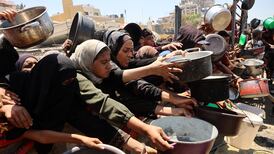Iraqi forces recaptured territory east of Ramadi from Islamic State militants on Tuesday, linking the Anbar provincial capital to a major army base nearby.
Officials appealed for international funding to help clear the city of explosives.
Iraq’s army declared victory in December over Islamic State, also known as Isis, in Ramadi after elite counter-terrorism forces seized the main government building, but it has taken weeks for the commandos to clear insurgents from the rural eastern outskirts.
The recapture of Ramadi was the first major gain for the US-trained force since it collapsed in the face of an assault by Islamic State in 2014. Ramadi’s recovery boosted Iraqi prime minister Haider al-Abadi in his quest to oust the militants from Mosul, northern Iraq’s biggest city, later this year.
A military statement broadcast on television said the army, police and counter-terrorism forces had retaken several areas including the town of Husaiba al-Sharqiya, about 10km (6 miles) east of Ramadi.
“[Iraqi forces] also managed to open the road from Ramadi to Baghdad that passes through al-Khaldiya,” the statement added, referring to a highway that links the city to the Habbaniya army base where US-led coalition forces are located.
“All of Ramadi has now been liberated,” Anbar’s governor Sohaib al-Rawi said, adding that the handover of authority to local police from the military was going smoothly.
Islamic State militants are still entrenched in some rural northern districts bordering the main east-west highway, according to security sources.
Mine clearing
“The biggest challenge we are facing is clearing the areas of mines, which is now being conducted through modest local efforts,” Mr Rawi told reporters in Baghdad.
Tuesday’s advance boosted government efforts to close in on Falluja, the Islamic State stronghold located between Ramadi and Baghdad now being besieged by the Iraqi army and allied, Iranian-backed Shia Muslim militias.
The ultra-hardline Sunni militants of Islamic State swept through a third of Iraq in 2014, declaring a caliphate in Iraq and Syria, carrying out mass killings and imposing a draconian form of Islam, but have since been pushed back on various fronts.
United Nations efforts to stabilise Ramadi in preparation for the expected return of hundreds of thousands of displaced civilians are expected to cost around $50 million (€44 million), according to Lise Grande, the humanitarian co-ordinator in Iraq.
International donors
She said this would include $15 million for removing hundreds of improvised explosive devices planted by Islamic State on roads and in buildings. Ms Grande appealed to international donors to augment the $10 million fund allocated for that operation.
“At the rate that extraction is going with the limited capacity that exists, it will be up to nine months before the area of Tamim is cleared,” she said, referring to a large southern district of Ramadi where the first phase of UN efforts will be conducted.
The UN also plans to rehabilitate health and energy infrastructure in Ramadi, much of which was destroyed in fighting that included Islamic State bomb attacks and US-led coalition air strikes.
“Thousands of homes have to be rebuilt, thousands of buildings have to be rebuilt. The total cost of reconstruction in Ramadi is huge,” Ms Grande added.
– (Reuters)











